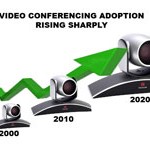Meetings have always been an important part of everyone’s work day. Whether it’s meeting a client to conclude a business deal, meet with a supervisor to plan work strategies and to discuss performance, or meeting colleagues within a work group to address issues, tactics and objectives, it has always been a core requirement for most professionals in any industry.
Gone are the times, however, when meetings were held prevalently face-to-face; new technologies are now transforming the way this business staple is being conducted. Over the years, Internet-mediated communication (IMC) has taken place; communication technology has evolved to include video conferencing that has enabled telepresence meetings amongst distributed workers in real-time. This has changed business communication.

Online meetings in the workplace, through mobile devices or from home, can allow participants to successfully have face-to-face conversations and collaborate on matters wherever they are. Through video conference systems, professionals can discuss and share documents, display information and give PC presentations, if they like, without the need to travel to a particular location; now Internet conferencing and technologies like cloud computing are making it possible for anyone, even without sophisticated IT infrastructure to meet anywhere at any time; technology has removed the physical distance between parties.
Whether this new way of getting together is as effective as traditional, face-to-face, interactive meetings seated around a conference table, is still a matter of discussion.
According to a report by Blue Jeans Network on Modern Meetings, in fact, only traditional meetings allow for the shaping of true business relationships. The report shows how meetings of different types take even half of the normal workday of a professional. Most meetings last 45 minutes and take place between 10:00 am and 2:00 pm, normally on Tuesday and Wednesday.
Video meetings, although the most frequent, are not always the choice; they are used normally in sales pitches, when doing customer support appearances and internal panel reviews, in HR for recruiting and training. They are also used when conducting office meetings involving remote and satellite locations, for board and executive meetings.

The technology used, according to the CMSWire report covering the topic, “Meetings, Mobility and How We Spend Half Our Time at Work,” does not always involve proprietary solutions like Skype. Thanks to the advancement of WebRTC, an open-source browser-based real time communication solution, everyone can join meetings from disparate types of computers and smart mobile devices (SMDs) without anything but a browser.
With WebRTC, personnel can join meetings at any time, during commute and outside normal business hours. Interestingly, this fairly new concept for flexibility in meetings is met with favor by women who are 14 percent more likely than men to attend in general, and 12 percent more likely to attend on weekends. This might be due to being able to juggle better family and personal life demands with work thanks to less rigidity in meetings time and connection type.
There are, however, negative aspects pointed out in the CMSWire report. Seventy-one percent of respondents, in fact, have admitted losing a deal due to the lack of face-to-face communication. Interest is also an issue, as six percent even confessed falling asleep during audio-only meetings.
Modern meetings also pose more demands on companies’ IT departments. This is due to the need to accommodate video and audio participants (39 percent of video meetings also have one audio participant) and to be able to incorporate presentations, videos and other visual aids for everyone to share.
Nevertheless meetings are important to get professionals together and to facilitate collaboration and exchanges. Much research has been conducted on whether meetings are actually conducive to good decision-making and to optimal collaboration. In particular, a study from The University of Alabama in Huntsville found that it’s not how and when people meet or the technology used to meet that determines the outcome of a meeting, but the way the time is spent and the way participants interact. Online meetings, then, are just as effective as traditional meetings as long as all parties involved clearly know their roles and responsibility in the decision-making process.
Edited by
Cassandra Tucker